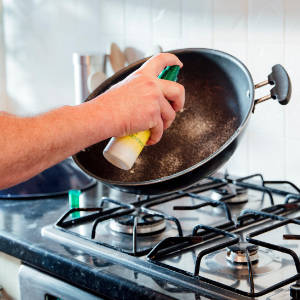Fats & Oils Category

annatto oil
Annatto oil adds a bright red color and some flavor to foods. It is prepared by grinding annatto seeds and mixing the powder with oil.
Learn moreannatto paste
Annatto paste adds a bright red color and some flavor to foods. It is prepared by grinding annatto seeds and mixing the powder with lard.
Learn morebacon grease
This is the fat that remains in the pan after cooking bacon. It's very flavorful, but high in cholesterol.
Learn morebutter
This is a delicious solid fat churned from milk. It's used in baking, frying, and as a spread on toast and muffins. Recipes that call for butter in most better cookbooks are referring to unsalted butter = sweet cream butter = sweet butter. Salted butter doesn't spoil as readily (the salt serves as a preservative). See also the entries for whipped butter and European-style butter.
Learn morecanola oil
Canola oil is a versatile, neutral-tasting oil that is very low in saturated fat. Puritan is a well-known brand.
Learn morecaul fat
Look for this in the meat sections of Asian, French, and Italian markets. Caul fat from pork is considered superior to caul fat from lamb.
Learn moreclarified butter
This is butter without the milk solids, so it doesn't go rancid or smoke when heated to a high temperature. Look for jars of it in Indian markets.
Learn morecopha
This is a shortening based on coconut oil that's commonly used in Australia. It's very hard to find in the U.S.
Learn moreEuropean-style butter
Plugra is a domestic brand. Since European-style butter has a lower moisture content, using it results in better pastries, icings, and sauces.
Learn moregrapeseed oil
This oil is pricey, but it has the highest smoke point of any oil, which makes it ideal for sautéing or frying over high heat. It's also a good salad oil. Some claim that it reduces the risk of heart disease by reducing LDL (bad cholesterol) levels in the body.
Learn morehazelnut oil
Nut oils are best used in cold dishes, as heat destroys their delicate flavor. Store in the refrigerator.
Learn morehot chili oil
Chinese cooks sometimes add a drop or so of this to dishes in order to heat them up. Look for small bottles of this in Asian markets and large supermarkets.
Learn morelard
Lard is rendered pork fat. It's high in saturated fat, and quite bad for you. Still, it's the fat of choice for making flaky pie crusts, though it's not as flavorful as butter. Some pastry chefs combine butter with lard to achieve a balance of flavor and flakiness. Lard is also used for frying since it can reach high temperatures without smoking. See also the entries for lard leaves and lardo.
Learn moremargarine
In addition to regular margarine, supermarkets usually carry diet margarine = lite margarine (with about half the fat and more water and air), soft margarine, whipped margarine (containing up to 50% air). These diet margarines make wonderful spreads, but they shouldn't be substituted for regular margarine in baked goods. For more information, visit the Illinois Cooperative Extension Service's Lite Margarine--Substitution for Baking page.
Learn moremustard oil
Mustard oil may be hard to find in the US. Indian markets would be your best bet.
Learn moreolive oil
ranked from highest to lowest quality; extra-virgin, superfine, fine, virgin, and pure.
Learn morepalm oil
This bright orange palm oil is a staple in Brazilian cuisine, but very high in saturated fat
Learn moresesame oil
includes light sesame oil and stronger dark sesame oil. Sesame oil has a low smoke point and is relatively expensive, so it's not good for frying.
Learn moreshortening
Shortening can be made from either animal fat or vegetable oil. Crisco is a popular brand.
Learn moresuet
It is the hard white fat on the kidneys and loins of cattle, sheep, and other animals, used to make foods including puddings, pastry, and mincemeat. Your butcher will probably give some of this to you for free.
Learn more





































































































































































































































































































































































